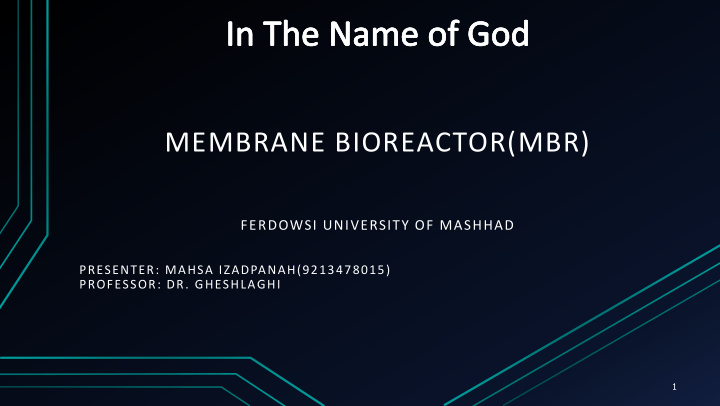



MEMBRANE BIOREACTOR(MBR) FERDOWSI UNIVERSITY OF MASHHAD PRESENTER: MAHSA IZADPANAH(9213478015) PROFESSOR: DR. GHESHLAGHI 1
Outline: 1. Introduction 2. MBR in wastewater treatment 3. Membrane (module-configuration) 4. Fouling mechanisms 5. Anti-fouling strategies 6. Membrane separation processes 2
Introduction Membrane bioreactor: membrane process +suspended growth bioreactor And is now widely used for municipal and industrial wastewater treatment. The original process was introduced by Dorr-Oliver. • Combined the use of an activated sludge bioreactor with a cross flow membrane filtration loop. The breakthrough for the MBR came in 1989 with the idea of Yamamoto and co-workers to submerge the membranes in the bioreactor. 3
Schematic of conventional activated sludge process (top) and membrane bioreactor (bottom) 4
5
Membrane: Semi permeable membrane: a phase acting as as a barrier that prevents the net motion of mass but permits the regulated and restricted passage of one or more species. Commercial membrane are generally classified according to: 1. the chemical nature of the material that are made of. 2. the morphology of the wall 3. the separation mechanism 4. the material physical-chemical properties 6
Membrane modules: • 7
Membrane modules: • 8
Membrane modules: • 9
Membrane modules: • 10
Two different MBR configurations: • Side stream (external) • Submerged (internal) 11
Internal (submerged) 12
External(side stream) 13
Fouling and fouling control: • The MBR filtration performance inevitably decreases with filtration time. • membrane fouling is the most serious problem affecting system performance. 14
Fouling mechanism: 1. Complete Blocking Filtration 2. Standard Blocking Filtration 3. Intermediate Blocking Filtration 4. Cake Filtration 15
Fouling mechanisms: hermia model for fouling mechanism: General equation: 1. Complete Blocking Filtration 16
2. Standard Blocking Filtration 3. Intermediate Blocking Filtration 4. Cake Filtration 17
Anti-fouling strategies: 1. The use of ultraviolet radiation to reduce membrane fouling 2. The use of ultrasound to reduce membrane fouling 3. Physical and chemical cleaning in order to reduce membrane fouling 18
19
Membrane separation processes Reverse osmosis Ultra-filtration Micro-filtration Nano- filtration 20
Reverse osmosis 21
Membrane technology comparison 22
Membrane technology comparison 23
Recommend
More recommend